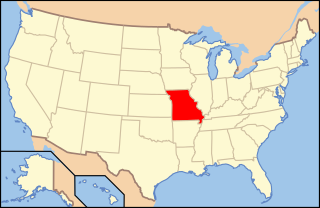
Missouri wine refers to wine made from grapes grown in Missouri. German immigrants in the early-to-mid-19th century founded the wine industry in Missouri, resulting in its wine corridor being called the Missouri "Rhineland". Later Italian immigrants also entered wine production. In the mid-1880s, more wine was produced by volume in Missouri than in any other state. Before prohibition, Missouri was the second-largest wine-producing state in the nation. Missouri had the first area recognized as a federally designated American Viticultural Area with the Augusta AVA acknowledged on June 20, 1980. There are now four AVAs in Missouri. In 2017 there were 125 wineries operating in the state of Missouri, up from 92 in 2009.

California wine has a long and continuing history, and in the late twentieth century became recognized as producing some of the world's finest wine. While wine is made in all fifty U.S. states, up to 90% of American wine is produced in the state. California would be the fourth largest producer of wine in the world if it were an independent nation.

Agoston Haraszthy was a Hungarian American nobleman, adventurer, traveler, writer, town-builder, and pioneer winemaker in Wisconsin and California, often referred to as the "Father of California Wine", alongside Junípero Serra, as well as the "Father of California Viticulture," or the "Father of Modern Winemaking in California". One of the first men to plant vineyards in Wisconsin, he was the founder of the Buena Vista Winery in Sonoma, California, and an early writer on California wine and viticulture.
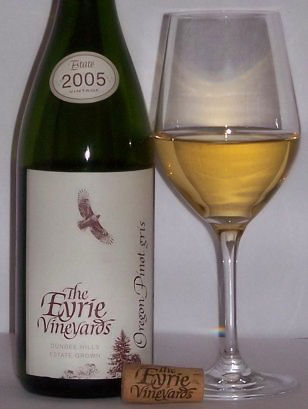
Wine has been produced in the United States since the 1500s, with the first widespread production beginning in New Mexico in 1628. As of 2023, wine production is undertaken in all fifty states, with California producing 80.8% of all US wine. The North American continent is home to several native species of grape, including Vitis labrusca, Vitis riparia, Vitis rotundifolia, and Vitis vulpina, but the wine-making industry is based almost entirely on the cultivation of the European Vitis vinifera, which was introduced by European settlers. With more than 1,100,000 acres (4,500 km2) under vine, the United States is the fourth-largest wine producing country in the world, after Italy, Spain, and France.

Washington wine is a wine produced from grape varieties grown in the U.S. state of Washington. Washington ranks second in the United States in the production of wine. By 2017, the state had over 55,000 acres (220 km2) of vineyards, a harvest of 229,000 short tons (208,000 t) of grapes, and exports going to over 40 countries around the world from the 940+ wineries located in the state. While there are some viticultural activities in the cooler, wetter western half of the state, the majority (99.9%) of wine grape production takes place in the shrub-steppe eastern half. The rain shadow of the Cascade Range leaves the Columbia River Basin with around 8 inches (200 mm) of annual rain fall, making irrigation and water rights of paramount interest to the Washington wine industry. Viticulture in the state is also influenced by long sunlight hours and consistent temperatures.

Napa Valley is an American Viticultural Area (AVA) located in Napa County, California. It was established by the Bureau of Alcohol, Tobacco and Firearms (ATF) on January 27, 1981. Napa Valley is considered one of the premier wine regions in the world. Records of commercial wine production in the region date back to the nineteenth century, but premium wine production dates back only to the 1960s.

The production of wine in New Jersey has increased significantly in the last thirty years with the opening of new wineries. Beginning in 1981, the state legislature relaxed Prohibition-era restrictions and crafted new laws to facilitate the growth of the industry and provide new opportunities for winery licenses. Today, New Jersey wineries are crafting wines that have earned recognition for their quality from critics, industry leaders, and in national and international competitions. As of 2019, New Jersey currently has 51 licensed and operating wineries with several more prospective wineries in various stages of development.

Texas has a long history of wine production. The sunny and dry climate of the major winemaking regions in the state have drawn comparison to Portuguese wines, in addition to other regions in Europe like Spain, France, and Italy. Some of the earliest recorded Texas wines were produced by Spanish missionaries in the 1650s near El Paso. Texas ranked as the fifth largest wine producing state by 2019.
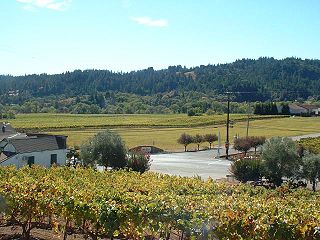
Sonoma County wine is wine made in Sonoma County, California, in the United States.
The Ohio River Valley AVA is an American Viticultural Area centered on the Ohio River and surrounding areas. It is the second largest wine appellation of origin in the United States with 16,640,000 acres (26,000 sq mi) (67,300 km2) in portions of the states of Indiana, Kentucky, Ohio and West Virginia. The area is mostly planted with hybrid grapes like Baco noir, Marechal Foch, Seyval blanc and Vidal. Of the Vitis vinifera found in the area Cabernet Franc, Cabernet Sauvignon, Chardonnay, Petit Manseng and Riesling are the most common. The AVA size was decreased by approximately 1,530 square miles when the Indiana Uplands AVA was established in 2013 composed of the bordering area in Indiana.

The Sonoma Valley AVA is an American Viticultural Area in Sonoma County, California which centers on the Sonoma Valley in the southern portion of the county. The name 'Sonoma' means 'Valley of the Moon' in the local Native American dialect. The appellation is bordered by two mountain ranges: the Mayacamas Mountains to the east and the Sonoma Mountains to the west.

Iowa wine refers to wine made primarily from grapes grown in the state of Iowa. The state was one of the largest wine producers in the country during the late 19th and early 20th centuries, but Prohibition put it out of business. Iowa presents many challenges to viticulture including very warm summer days that can promote fungal vine diseases, and extremely cold winter nights that can kill many varieties of grapevines. Most commercial viticulture in Iowa focuses on French hybrid and native American grape varieties, with relatively few plantings of Vitis vinifera grapes. Many Iowa wineries also import grapes and juice from other states and countries in order to produce wine varietals otherwise not possible due to Iowa's harsh winter months that will not permit such grapes to survive. Iowa is home to 100 commercial wineries and more than 300 vineyards covering 1,200+ acres. Northeastern Iowa is included in the Upper Mississippi Valley AVA while the western part of the state is in the new AVA designation named Loess Hills.
Gundlach Bundschu Winery is a historic winery and an outdoor concert venue located in Sonoma County. It is California's oldest continuously family-owned winery, and is the second oldest winery after Buena Vista Winery. It is still owned and operated by the founder's heirs and today led by the sixth generation, Jeff Bundschu. The winery's 320-acre (130 ha) regenerative organic certified estate vineyard, named Rhinefarm by Bavarian-born Jacob Gundlach in 1858, is located within the Sonoma Valley AVA of Sonoma County, at the crossroads of the Sonoma Valley, Los Carneros AVA and Napa Valley AVA, along the Mayacamas Mountains. They specialize in estate-driven, organically farmed Bordeaux reds and cool climate varietal wines.

California wine production has a rich viticulture history since 1680 when Spanish Jesuit missionaries planted Vitis vinifera vines native to the Mediterranean region in their established missions to produce wine for religious services. In the 1770s, Spanish missionaries continued the practice under the direction of the Father Junípero Serra who planted California's first vineyard at Mission San Juan Capistrano.
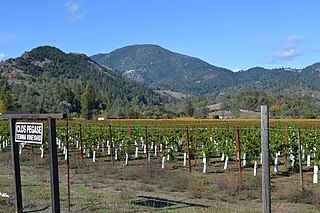
Napa County wine refers to the viticulture and winemaking in Napa County, California, United States. County names in the United States automatically qualify as legal appellations of origin for wine produced from grapes grown in that county and do not require registration with the United States Department of the Treasury Alcohol and Tobacco Tax and Trade Bureau (TTB). TTB was created in January 2003, when the Bureau of Alcohol, Tobacco and Firearms, or ATF, was extensively reorganized under the provisions of the Homeland Security Act of 2002.
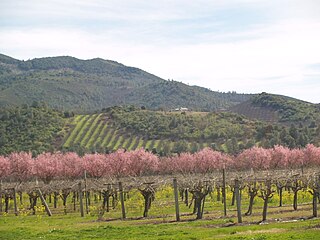
Lake County wine designates wine made from grapes grown mostly in Lake County, California. The region is located north of Napa County and east of Mendocino County. Although each region within Lake County has unique viticultural attributes, many are influenced by Clear Lake, the largest inland body of water in California.

The Cucamonga Valley AVA is an American Viticultural Area in San Bernardino County, California. It is in the Cucamonga Valley region of the Pomona Valley, about 15 miles (24 km) west of San Bernardino.

The Hermann AVA is an American Viticultural Area located in Gasconade County, Missouri, and entirely contained within the larger Ozark Mountain AVA. The wine appellation is located on the southern side of the Missouri River near the town of Hermann, about halfway between St. Louis and Jefferson City. The AVA covers the northernmost hills of the Ozark Plateau with many of the 200 acres of vineyards planted along hillside locations. As of 2007, seven wineries were producing wine in appellation, including Missouri's largest winery, Stone Hill Winery.

The Finger Lakes AVA is an American Viticultural Area located in Upstate New York, south of Lake Ontario. It was established in 1982 and encompasses the eleven Finger Lakes, but the area around Canandaigua, Keuka, Seneca, and Cayuga Lakes contain the vast majority of vineyard plantings in the AVA. Cayuga and Seneca Lakes each have their own American Viticultural Areas completely contained within the Finger Lakes AVA. The Finger Lakes AVA includes 11,000 acres (4,452 ha) of vineyards and is the largest wine-producing region in New York State.

Charles Krug (1825–1892) was among the pioneers of winemaking in the Napa Valley, California, and was the founder of the Charles Krug Winery.


















